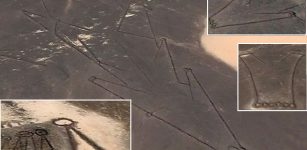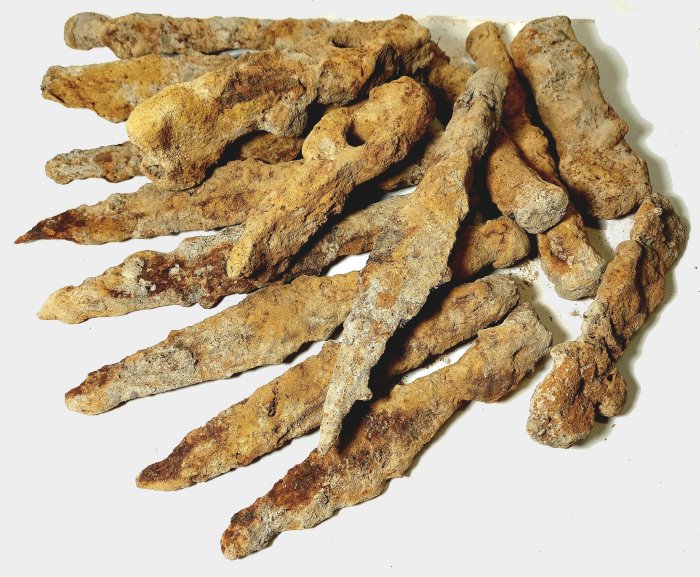Weapons Left By Barbarian Tribes Discovered In Polish Forest
Conny Waters - AncientPages.com - The Lublin Provincial Monuments Conservator has announced a 15 iron weapons that probably belonged to Barbarian tribes who fought the Romans have been discovered in a forest near the town of Hrubieszów in eastern Poland.
“We are most likely dealing with weapons used by barbarian tribes during the Roman Empire, perhaps with the Przeworsk culture,” the Hrubieszów Museum said in a statement.
A set of Barbarian weapons discovered by Mateusz Filipowicz in the State Forests in the Hrubieszów region. Credit: Lubelski Wojewódzki Konserwator Zabytków / B. Bartecki
The Barbarian weapons include spearheads, axes, and three objects that currently remain unidentified.
The term Barbarian is often misused today. "In modern times, we often say Barbarians are uncivilized people or evil people.
However, the true meaning of the word has been forgotten. The word originated in ancient Greece and initially referred to people who did not speak Greek." 1
All the weapons were found in one location in the forest. Credit: Adobe Stock - Pawel Michalowski
There were several Barbarian tribes. Among them are, for example, the Celts, Iberians, Scythians, Thracians, Illyrians, Sarmatians, Goths, Franks, Visigoths, Vandals, Lombards, and Ostrogoths.
Romans had disciplined and organized soldiers who often had difficulties fighting against Barbarians who applied entirely different military tactics. Germanic ghost warriors defeated many Roman soldiers. Unlike the Vikings, who confronted their enemy face to face, Germanic ghost warriors took advantage of nature and the element of surprise. It may have been a crude method, but it was certainly a successful military tactic. When ancient Romans entered their territory, they soon learned the Germanic ghost warriors had never bowed down to anyone and had no intentions of ever doing so.
Barbarians were trained in various deadly weapons, which they deliberately used in a chaotic manner, confusing organized soldiers.
The iron artifacts found in the State Forests in the Hrubieszów region provide scientists with more information on which weapons Barbarian tribes used.
Credit: Lubelski Wojewódzki Konserwator Zabytków / B. Bartecki
Unfortunately, the objects were discovered in a swampy area of the forest, and the metal is heavily corroded, and some of the artifacts are difficult to identify.
"Several kilograms of shapeless muddy corroded iron were safely packed up and taken out of the forest to clean and determine the nature of the find," Dariusz Kopciowski, the local conservative of monuments, told local news outlet Lublin112.
Almost all of the artifacts were found at the same spot, and archaeologists already have a preliminary theory about the origin of the weapons.
"We are most likely dealing with weapons used by Barbarian tribes during the Roman Empire, perhaps with the Przeworsk culture (1st century B.C. - 2nd/3rd century A.D.)," the museum's conservator said.
There are no known archaeological sites in the area of the discovery, which explains why no bones, pottery, or other artifacts were unearthed at the site. It would seem that someone deliberately collected these weapons, packed them in a bag or other organic container, and then threw them into the swamp.
See also: More Archaeology News
For many years, while showing our guests around, we mentioned that somewhere in the Hrubieszów forest, there must have been a place where the Goths used weapons. Let us remember that the Goths did not put iron objects in their graves. These spears, swords, axes, and other military equipment must be somewhere, and it is only a matter of time before we find one of such places," the Hrubieszów museum added in a statement.
The weapons will now be thoroughly analyzed. The study should reveal the age and origin of these objects.
In spring, researchers will re-examine the site where the 15 weapons of the Barbarians were found.
Written by Conny Waters - AncientPages.com Staff Writer
Expand for referencesMore From Ancient Pages
-
 Oldest Evidence Of Beer Comes From Raqefet Cave, Dating Back To 11,000 B.C.
Archaeology | Sep 27, 2024
Oldest Evidence Of Beer Comes From Raqefet Cave, Dating Back To 11,000 B.C.
Archaeology | Sep 27, 2024 -
 Why Didn’t Alexander The Great’s Body Show Signs Of Decomposition For Several Days? A Never-Before Suggested Explanation – From Scientists
Archaeology | Jan 24, 2019
Why Didn’t Alexander The Great’s Body Show Signs Of Decomposition For Several Days? A Never-Before Suggested Explanation – From Scientists
Archaeology | Jan 24, 2019 -
 Unique 17th Century Silk Dress Found At Bottom Of The Wadden Sea Goes On Display
Artifacts | Jul 29, 2023
Unique 17th Century Silk Dress Found At Bottom Of The Wadden Sea Goes On Display
Artifacts | Jul 29, 2023 -
 Mystery Of The Lost Anglo-Saxon Queen Cynethryth May Soon Be Solved By Archaeologists
Archaeology | Aug 2, 2022
Mystery Of The Lost Anglo-Saxon Queen Cynethryth May Soon Be Solved By Archaeologists
Archaeology | Aug 2, 2022 -
 First Cemetery Dated To Roman Period Discovered In North Saqqara, Egypt
Archaeology | Nov 12, 2019
First Cemetery Dated To Roman Period Discovered In North Saqqara, Egypt
Archaeology | Nov 12, 2019 -
 Valhalla – The Hall Of The Fallen Where Viking Hero Warriors ‘Einherjar’ Dwell After Death
Featured Stories | Mar 11, 2018
Valhalla – The Hall Of The Fallen Where Viking Hero Warriors ‘Einherjar’ Dwell After Death
Featured Stories | Mar 11, 2018 -
 Strange Story Of Tecumseh’s Comet, Black Sun Prophecy And New Madrid Earthquakes – The Biggest Earthquakes In American History
Ancient Mysteries | Nov 14, 2018
Strange Story Of Tecumseh’s Comet, Black Sun Prophecy And New Madrid Earthquakes – The Biggest Earthquakes In American History
Ancient Mysteries | Nov 14, 2018 -
 1,000-Year-Old Church Walls Unearthed In Ethiopia By Polish Archaeologists
Archaeology | Apr 26, 2020
1,000-Year-Old Church Walls Unearthed In Ethiopia By Polish Archaeologists
Archaeology | Apr 26, 2020 -
 Ostracism: Political Practice In Ancient Athens
Ancient History Facts | May 7, 2019
Ostracism: Political Practice In Ancient Athens
Ancient History Facts | May 7, 2019 -
 Almost 3,000 Year-Old Burial Site Of Urartian Royals Discovered In Turkey’s Famous Van
Archaeology | Jul 31, 2019
Almost 3,000 Year-Old Burial Site Of Urartian Royals Discovered In Turkey’s Famous Van
Archaeology | Jul 31, 2019 -
 Secret Ancient Knowledge Of Portals Leading To Unknown Realms – Mysteries Of The Past And Present – Part 2
Ancient Mysteries | Dec 7, 2021
Secret Ancient Knowledge Of Portals Leading To Unknown Realms – Mysteries Of The Past And Present – Part 2
Ancient Mysteries | Dec 7, 2021 -
 Analysis Of Ancient Tools Challenges Long-Held Ideas About What Drove Major Changes In Ancient Greek Society
Archaeology | Aug 23, 2022
Analysis Of Ancient Tools Challenges Long-Held Ideas About What Drove Major Changes In Ancient Greek Society
Archaeology | Aug 23, 2022 -
 Unknown Ancient Settlement Overlapping The Old City Of Nakhon Ratchasima Discovered
Archaeology | Mar 14, 2025
Unknown Ancient Settlement Overlapping The Old City Of Nakhon Ratchasima Discovered
Archaeology | Mar 14, 2025 -
 Historic Event – Exeter Museum Returns Ceremonial Dress Of Famous Chief Crowfoot To Canada’s Siksika People
Artifacts | May 20, 2022
Historic Event – Exeter Museum Returns Ceremonial Dress Of Famous Chief Crowfoot To Canada’s Siksika People
Artifacts | May 20, 2022 -
 African Kingdom Of Axum – Ancient Ruins Of Early Churches Unearthed
Archaeology | Dec 9, 2022
African Kingdom Of Axum – Ancient Ruins Of Early Churches Unearthed
Archaeology | Dec 9, 2022 -
 On This Day In History: ‘Earl of Northumberland’ Thomas Percy Executed Because He Was Catholic – On August 22, 1572
News | Aug 22, 2016
On This Day In History: ‘Earl of Northumberland’ Thomas Percy Executed Because He Was Catholic – On August 22, 1572
News | Aug 22, 2016 -
 5,000-Year-Old Stone Paint Palette Unearthed In Küllüoba Mound
Archaeology | Sep 9, 2020
5,000-Year-Old Stone Paint Palette Unearthed In Küllüoba Mound
Archaeology | Sep 9, 2020 -
 Human Footprints Dating Back 800,000 Years Discovered In Norfolk UK
Archaeology | Feb 7, 2014
Human Footprints Dating Back 800,000 Years Discovered In Norfolk UK
Archaeology | Feb 7, 2014 -
 400 Mysterious Stone Formations That Could Be 7,000 Years Old Spotted In Google Earth Satellite Images Over Saudi Arabia
Archaeology | Oct 19, 2017
400 Mysterious Stone Formations That Could Be 7,000 Years Old Spotted In Google Earth Satellite Images Over Saudi Arabia
Archaeology | Oct 19, 2017 -
 2,000-Years-Old Warrior Graves With Iron Swords, Mysterious Square Structures, Unearthed In Bejsce, Poland
Archaeology | Nov 21, 2019
2,000-Years-Old Warrior Graves With Iron Swords, Mysterious Square Structures, Unearthed In Bejsce, Poland
Archaeology | Nov 21, 2019



